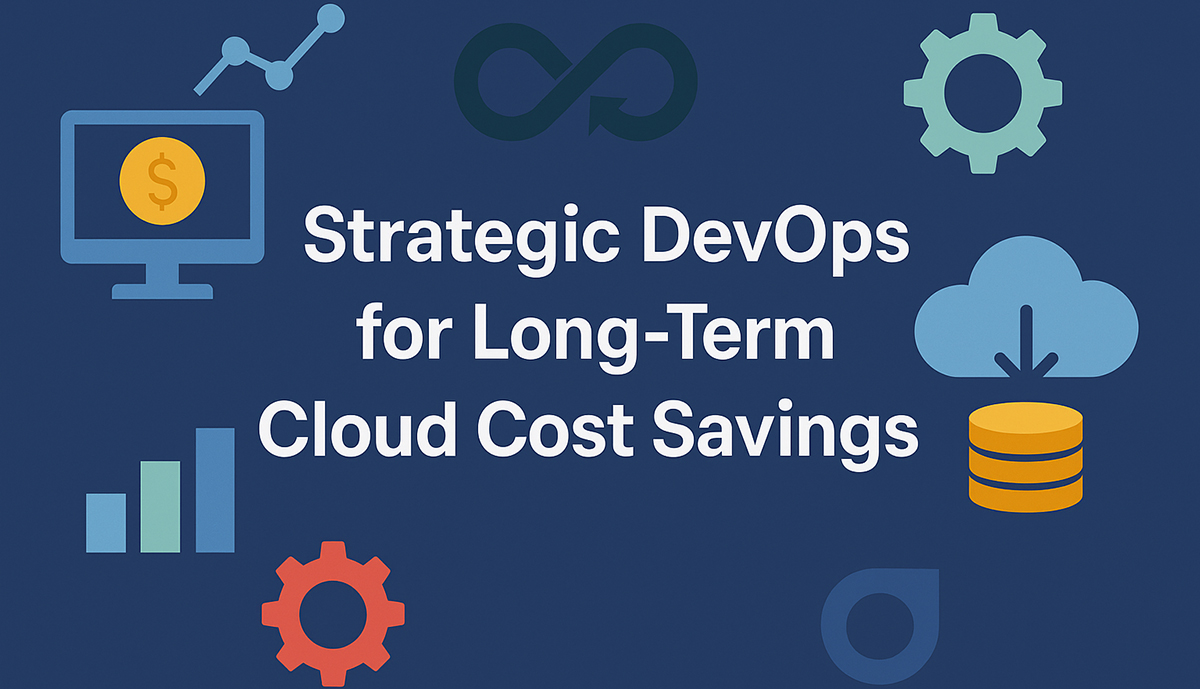No products in the cart.
 In today’s cloud-dominated ecosystem, DevOps is no longer just a productivity engine—it’s a financial lever. Speed and agility are vital, but they come with a hefty price tag if not managed wisely. As businesses scale operations, a new imperative arises: achieving cloud efficiency without sacrificing innovation. Striking the right balance hinges on effective DevOps cost optimization strategies.
In today’s cloud-dominated ecosystem, DevOps is no longer just a productivity engine—it’s a financial lever. Speed and agility are vital, but they come with a hefty price tag if not managed wisely. As businesses scale operations, a new imperative arises: achieving cloud efficiency without sacrificing innovation. Striking the right balance hinges on effective DevOps cost optimization strategies.
Why Cost Optimization Is a DevOps Imperative
With DevOps practices driving rapid deployments and continuous delivery, cloud expenses can spiral quickly. Always-on environments, multiple test setups, and automation scripts all add to the bottom line. What once felt like a gain in agility can become a drain on resources. As a result, optimizing cloud usage has become a core strategic priority, ensuring that each line of code contributes to value, not waste.
Cloud Efficiency: The New Standard in DevOps
DevOps pipelines have evolved into dynamic, interconnected systems powered by microservices, containers, and serverless architectures. In such fluid environments, waste can proliferate fast. Efficiency today means aligning cloud consumption with real-time needs—scaling with precision, automating intelligently, and eliminating redundancies wherever possible.
Understanding How DevOps Drives Cloud Spend
DevOps accelerates change, often spinning up infrastructure with Infrastructure as Code (IaC) and running compute-heavy CI/CD processes. Without tight governance, these actions increase costs subtly but significantly. While continuous delivery improves time to market, it can also mask financial inefficiencies baked into the automation.
Hidden Culprits of Overspending
Common causes of cloud overspend include idle resources, over-provisioned virtual machines, and forgotten services left running long after their purpose is served. Storage is another silent drain—redundant backups, unused snapshots, and bloated containers add up. Inefficient CI/CD workflows also tend to re-execute tasks unnecessarily, thereby escalating costs without yielding equivalent outcomes.
Creating a Culture of Cost-Aware Engineering
FinOps emerges as a framework that unites financial governance with technical performance optimization. By integrating FinOps principles, teams can better evaluate trade-offs between cost and performance. Cost metrics should be as visible to developers as latency or uptime. Dashboards, cost alerts, and plugin integrations can guide more informed decisions throughout the development lifecycle.
Smarter Infrastructure: Right-Sizing and Auto-Scaling
With auto-scaling, workloads expand and contract in response to usage patterns, ensuring efficient resource utilization and minimal waste. But misconfigured thresholds can lead to overuse or instability. Similarly, right-sizing resources—adjusting compute, storage, and bandwidth to actual usage—ensures businesses pay for exactly what they need, not more.
Leveraging Tools for Cost Efficiency
Platforms like AWS and Azure provide native cost management tools, including Cost Explorer and Azure Cost Management, for tracking and analyzing cloud spending. Third-party platforms such as CloudHealth and Spot.io go further, offering predictive analytics and optimization recommendations. Proper tagging and resource tracking by project or team bring clarity and accountability to cloud bills.
Shift Left to Save Early
Proactively embedding cost optimization into initial planning minimizes the need for corrective actions down the line. Stateless microservices, caching, and event-driven architectures provide lean, scalable foundations. Likewise, containers and serverless solutions eliminate persistent infrastructure, offering pay-per-use models ideal for DevOps speed and budget constraints.
Automation With Purpose
Automation shouldn’t mean over-engineering. Adding unnecessary tools or stages to the pipeline increases complexity and cost without real value. The goal is to automate repetitive tasks, standardize chaos, and avoid bloat. AIOps platforms like Datadog or New Relic help identify anomalies—catching issues like memory leaks or misconfigured services before they impact finances.
Monitoring Metrics That Matter
DevOps teams focused on cost efficiency extend their monitoring to include metrics beyond traditional CPU and memory usage. They examine usage-to-provisioning ratios, cost per deployment, and service efficiency. Financial alerts flag anomalies like cost spikes, often pointing to bugs or wasteful deployments. Timely insights allow teams to take corrective action in advance of potential overspending.
Real-World Optimization Wins
A SaaS provider slashed cloud costs by 40% after streamlining its CI/CD pipelines. A fintech firm saw a 60% drop in idle compute usage by switching to serverless architecture. These are not isolated cases—they reflect a broader shift toward intelligent, deliberate infrastructure management.
Designing for the Future
Efficient DevOps strategies are built around ephemeral infrastructure, automated decommissioning, and flexible, scalable design principles. AI and machine learning will soon play a leading role—predicting spend anomalies and making real-time adjustments. The future of cost optimization is smart, adaptive, and built into every layer of DevOps.
Stay updated! Follow us on social media! Facebook, Twitter, LinkedIn
Check out our newest blog entry ( Effortless IaaS Management Using VMware Cloud Foundation
)
Subscribe to get free blog content to your Inbox


